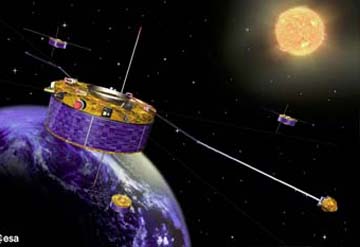International satellite workshop

An international team of scientists at Lancaster University is trying to predict “space weather” in an attempt to prevent global power failures and damage to satellites.
The researchers from Europe, the USA, China and the UK are investigating measurements from satellites orbiting the Earth together with data from a worldwide network of ground-based experiments.
The aim is to try to predict the effects of geomagnetic storms, when electrically charged particles from the sun enter the Earth’s atmosphere.This can damage defence and telecommunications satellites and overload electricity networks on the ground, causing power failures across whole continents. Aircraft may also have to be diverted because of the risk of high doses of radiation.
Dr Jim Wild, from Lancaster’s Space Plasma Environment and Radio Science group at InfoLab21, organised the international workshop.
He said: “This research is very relevant to today’s technologically dependent society where a geomagnetic storm can play havoc with radio communications.
“A large part of Canada once lost power because of this and it can also mean aircraft being diverted, so using up more fuel on longer routes and delays for passengers.
“If we could predict when these storms were likely to occur, we could plan ahead.”
The researchers are studying data from the four-satellite “Cluster”, operated by the European Space Agency, and the two-satellite “Double Star”, operated by the ESA and the China National Space Agency.
Dr Wild said: “The satellites are designed to study the magnetosphere – the region of near-space dominated by the Earth’s magnetic field – and investigate the electromagnetic connection between the sun and Earth.
“Disturbances in this coupling to the Sun – often called “space weather”- can lead to electrically charged particles of solar origin entering the upper layers of the Earth’s atmosphere.
“The most striking natural effects of space weather are the Aurora Borealis of “northern lights” but a large influx of charged particles can damage Earth-orbiting satellites and play havoc with radio communications.
“Electrical currents flowing through the upper atmosphere can also overload electricity network distribution networks on the ground.”
By combining data from instruments such as ionospheric radars, magnetometers and auroral imagers with satellite data, the scientists are trying to find out when this is likely to happen.
Dr Steve Milan from Leicester University said: “The goal is to predict how the sun will behave and shut down satellites on those days to save them being knocked out because just one satellite costs hundreds of millions of pounds.”
Professor Yang Huigen from the Polar Research Institute of China said it was good to share information.
“We need to collaborate because we are scientists in different countries, with different instruments and different sets of data and we need to make sense of these.”
http://www.dcs.lancs.ac.uk/research/spears/